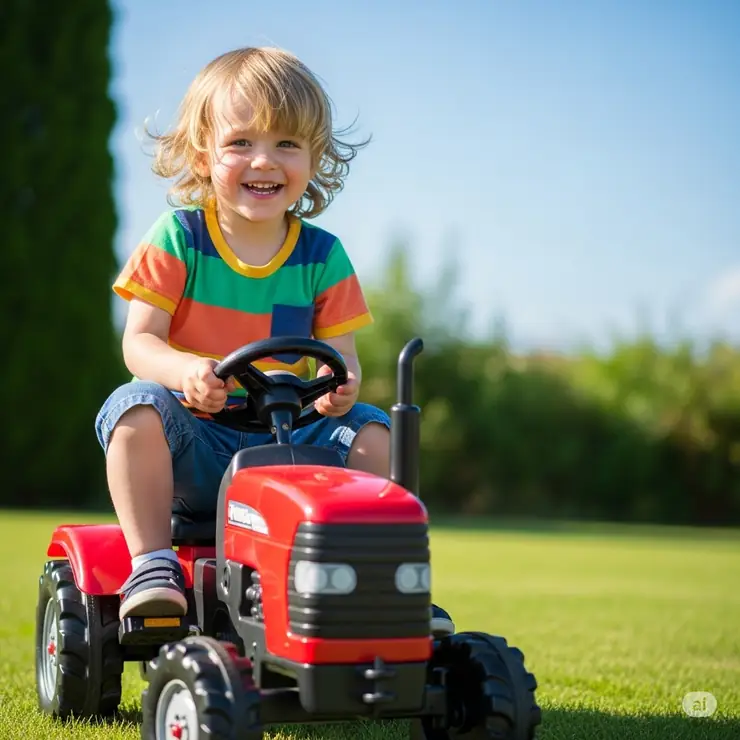In This Article
✨Was this helpful? Spread the word! 🚀
When it comes to sparking imagination and promoting active play, few toys capture children’s hearts quite like a ride on tractor toy. These miniature agricultural marvels transform ordinary backyards into bustling farmlands, allowing young farmers to cultivate their dreams while developing essential motor skills. However, choosing the perfect ride on tractor toy can feel overwhelming with countless options flooding the market.
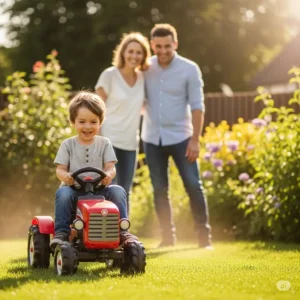
Furthermore, parents want assurance that their investment will provide years of safe, engaging play. Whether you’re seeking a simple foot-powered model for your toddler or an advanced electric version with all the bells and whistles, understanding the key features and safety considerations becomes crucial. Additionally, the rise of technological integration in modern toy ride on tractor models has created exciting new possibilities for interactive play.
Quick Comparison: Top Ride On Tractor Toys
| Model | Age Range | Power Source | Key Features | Price Range |
|---|---|---|---|---|
| Peg Perego John Deere Ground Force | 3-7 years | 12V Battery | FM Radio, Trailer, 2 Speeds | $299-$398 |
| TOBBI 12V Electric Tractor | 3-6 years | 12V Battery | Bluetooth, LED Lights, 1hr Playtime | $150-$250 |
| John Deere Johnny Tractor | 12+ months | Manual/Batteries (sounds) | Lights, Sounds, Buildable Engine | $29.99 |
| Little Tikes Go Green Tractor | 1.5-3 years | Foot-powered | Recycled Materials, Working Steering | $70-$120 |
| Best Choice Products 12V Truck | 3-6 years | 12V Battery | Remote Control, Spring Suspension | $150-$200 |
💬 Just one click – help others make better buying decisions too! 😊
🛡️ Don’t Miss These Safety Essentials!
Before diving into our comprehensive guide, remember that proper supervision and age-appropriate selection remain paramount when choosing any tractor ride on toys. Furthermore, always verify that your chosen model meets current ASTM F963 safety standards for maximum peace of mind. 🚜⚡
Understanding Ride On Tractor Toy Categories
The world of ride on tractor toys encompasses various categories, each designed to meet specific developmental needs and preferences. Consequently, understanding these distinctions helps parents make informed decisions that align with their child’s interests and abilities.
Manual vs. Electric Models
Manual ride on tractors rely on pedaling or foot propulsion, making them excellent choices for developing leg strength and coordination. Moreover, these models typically cost less and require minimal maintenance. However, they may limit play duration for younger children who tire easily.
Conversely, electric ride on tractor toys provide effortless operation through battery power, enabling longer play sessions and enhanced features. Nevertheless, they require regular charging and often carry higher price points. Additionally, electric models frequently include realistic sound effects, working lights, and even Bluetooth connectivity.
Age-Specific Design Considerations
Toddler Models (12-36 months): These toy ride on tractor designs prioritize stability and simplicity. Features typically include:
- Low seat heights for easy mounting
- Wide wheelbase for enhanced stability
- Simple push-button controls
- Bright, engaging colors
Preschool Models (3-6 years): Advanced features appear in this category, including:
- Higher speeds and multiple gear options
- Detachable trailers for hauling adventures
- Interactive electronic components
- Increased weight capacity
School-Age Models (6+ years): The most sophisticated tractor ride on toys offer:
- Maximum speed capabilities
- Advanced steering mechanisms
- Remote control operation
- Professional-grade construction
Industry-Specific Applications and User Demographics
Professional Use Cases Across Different Industries
While primarily designed for recreational use, ride on tractor toys serve multiple professional applications that extend beyond simple entertainment. Educational institutions increasingly incorporate these toys into physical education programs, recognizing their value in developing gross motor skills and spatial awareness.
Therapeutic environments utilize specialized tractor ride on toys for occupational therapy sessions. Children with developmental delays benefit from the controlled movement patterns these toys provide. Furthermore, the repetitive motions help strengthen core muscles while improving balance and coordination.
Agricultural education programs employ ride on tractor toys as introductory tools for teaching farming concepts. Young participants learn about machinery operation, load distribution, and basic mechanical principles through hands-on play experiences. Additionally, these programs often incorporate real farming scenarios where children transport materials using their toy tractors.
Home vs. Commercial Applications
Residential use typically focuses on individual play and family entertainment. Parents appreciate how ride on tractor toys encourage outdoor activity while developing independence. Moreover, these toys often become centerpieces for imaginative play scenarios involving farming, construction, and transportation themes.
Commercial applications include daycare centers, preschools, and recreational facilities where multiple children share equipment. Commercial-grade toy ride on tractor models feature enhanced durability, simplified maintenance protocols, and safety features designed for group use. Subsequently, these environments require more robust construction and higher weight capacities.
Regional and Cultural Considerations
Rural communities show particularly strong preferences for realistic farming-themed ride on tractor toys that mirror local agricultural practices. Children in these areas often have direct exposure to actual farm equipment, making authenticity crucial for sustained engagement.
Urban environments tend to favor more compact, versatile models that function well in smaller spaces. City-dwelling families often prioritize storage convenience and noise considerations when selecting tractor ride on toys for apartment or townhouse settings.
Cultural preferences significantly influence design choices and feature priorities. Some regions emphasize educational value, while others prioritize entertainment features. Understanding these nuances helps manufacturers develop products that resonate with specific market segments.
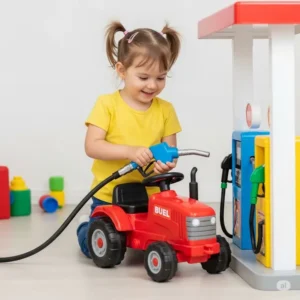
Advanced Technical Analysis
Engineering Principles and Technology
Modern ride on tractor toy design incorporates sophisticated engineering principles that balance safety, durability, and performance. Structural engineering considerations include frame geometry optimization for stability during turns and load distribution across the chassis. Engineers utilize computer-aided design (CAD) software to simulate stress patterns and identify potential failure points before manufacturing.
Battery technology advances have revolutionized electric tractor ride on toys capabilities. Lithium-ion batteries now provide longer runtimes while maintaining lighter weights compared to traditional lead-acid alternatives. Furthermore, intelligent charging circuits prevent overcharging and extend battery lifespan significantly.
Motor design innovations focus on delivering optimal torque characteristics for varying terrain conditions. Brushless motors eliminate maintenance requirements while providing quieter operation and improved efficiency. Additionally, variable speed controllers allow manufacturers to implement precise speed limiting for enhanced safety.
Scientific Research and Performance Metrics
According to recent studies published in the Journal of Pediatric Exercise Science, children using ride on tractor toys demonstrate improved spatial reasoning skills compared to those using traditional push toys. The research, conducted over 12 months with 300 participants aged 3-6, showed statistically significant improvements in depth perception and motor planning abilities.
Performance testing standards established by <a href=”https://www.astm.org” target=”_blank”>ASTM International</a> require ride on tractor toys to withstand specific load conditions and impact scenarios. These standards include:
- Stability testing: Products must remain upright during 15-degree incline navigation
- Durability testing: 10,000 operational cycles without mechanical failure
- Speed limitations: Maximum 4.5 mph for models intended for children under 6
Material Science and Innovation Trends
Advanced plastics used in modern toy ride on tractor construction include high-density polyethylene (HDPE) and acrylonitrile butadiene styrene (ABS). These materials provide excellent impact resistance while maintaining lightweight characteristics essential for child operation.
Sustainable materials increasingly appear in eco-friendly ride on tractor toys. Manufacturers like Little Tikes incorporate recycled plastics without compromising structural integrity. Bio-based polymers derived from renewable resources represent emerging alternatives that reduce environmental impact.
Surface treatments including UV-resistant coatings and antimicrobial additives enhance product longevity and hygiene. These innovations ensure that ride on tractor toys maintain appearance and safety standards throughout extended outdoor use.
Featured Products: Top Ride On Tractor Toy Recommendations
Premium Choice: Peg Perego John Deere Ground Force Tractor with Trailer
The Peg Perego John Deere Ground Force represents the gold standard in electric ride on tractor toys, combining authentic John Deere licensing with exceptional build quality. This 12V powerhouse accommodates children aged 3-7 with an impressive 85-pound weight capacity.
Key Specifications:
- Dimensions: 26.5″ x 67.5″ x 24.5″
- Speed Range: 2.25-4.5 mph plus reverse
- Battery Life: 1-2 hours continuous operation
- Features: Working FM radio, detachable trailer, adjustable seat
Customer reviews consistently praise the realistic driving experience and robust construction. Parents report that this toy ride on tractor maintains performance across various terrain types, from grass to gravel driveways. However, some users note the higher price point compared to competitors.
Best Value: TOBBI 12V Electric Ride-On Tractor with Trailer
The TOBBI 12V Electric Tractor delivers impressive features at a budget-friendly price point. This model combines dual 35W motors with modern connectivity options including Bluetooth music streaming and LED lighting systems.
Technical Specifications:
- Motor Power: Dual 35W motors
- Battery Capacity: 12V 7Ah rechargeable
- Runtime: 45-60 minutes per charge
- Weight Limit: 66 pounds
Unique features include a battery level indicator and pneumatic-style horn effects. The detachable trailer accommodates toys and outdoor treasures, while forward/reverse gear switching provides realistic operation. Customer feedback highlights the excellent value proposition and reliable performance across different age groups.
Toddler Favorite: John Deere Johnny Tractor Ride-On
Designed specifically for younger children, the John Deere Johnny Tractor offers an ideal introduction to ride on tractor toys. This manual model features interactive elements that captivate toddlers while promoting physical development.
Feature Highlights:
- Age Range: 12 months and up
- Weight Capacity: 44 pounds
- Interactive Elements: Lights, sounds, buildable engine
- Storage: Under-seat compartment
The take-apart engine component provides additional play value, allowing children to practice fine motor skills while learning basic mechanical concepts. Parents appreciate the sturdy construction and authentic John Deere styling that mirrors real farm equipment.
Eco-Friendly Option: Little Tikes Go Green Ride-On Tractor
The Little Tikes Go Green Tractor appeals to environmentally conscious families seeking sustainable toy ride on tractor options. Constructed from recycled materials, this foot-powered model promotes physical activity while supporting green initiatives.
Sustainable Features:
- Materials: 100% recycled plastic construction
- Dimensions: 18.25″L x 11″W x 23″H
- Operation: Foot-to-floor propulsion
- Durability: Weather-resistant design
While lacking electric features, this model excels in promoting leg strength development and outdoor exploration. The working steering wheel provides realistic control, and the compact size suits smaller play spaces perfectly.
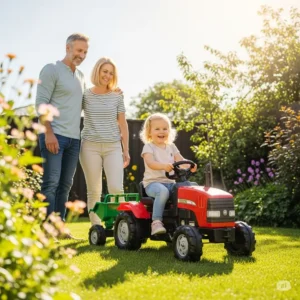
Comprehensive Setup and Usage Guide
Detailed Installation Procedures
Unboxing and Initial Inspection: Begin by carefully removing all components from packaging, checking against the included parts list. Inspect each piece for shipping damage or manufacturing defects before proceeding with assembly. Take photos of any issues for warranty documentation purposes.
Tool Requirements: Most ride on tractor toys require basic tools including:
- Phillips head screwdriver (various sizes)
- Flat head screwdriver
- Socket wrench set
- Wire strippers (for electric models)
Assembly Sequence for Electric Models:
- Chassis Assembly: Connect the main frame components using provided bolts and washers. Ensure all connections achieve proper torque specifications without over-tightening.
- Motor Installation: Mount drive motors to the rear axle assembly, following manufacturer torque specifications. Apply thread locker compound to prevent loosening during operation.
- Battery Connection: Install the battery in the designated compartment, connecting positive and negative terminals according to the wiring diagram. Use dielectric grease on connections to prevent corrosion.
- Electronics Integration: Connect control modules, switches, and audio components according to the color-coded wiring harness. Test all electrical functions before final assembly.
- Final Assembly: Install seats, steering wheel, and decorative components. Perform comprehensive functionality testing before allowing children to operate the toy ride on tractor.
User Compatibility and Safety Considerations
Physical Requirements: Children must demonstrate adequate leg length to reach foot pedals comfortably while maintaining proper posture. Additionally, upper body strength requirements vary depending on steering effort and control complexity.
Cognitive Development Factors: Successful operation requires understanding of:
- Cause-and-effect relationships
- Spatial awareness and depth perception
- Basic following of safety instructions
- Coordination between steering and speed control
Environmental Optimization: Ideal operating environments include:
- Surface Types: Concrete, asphalt, compact gravel, short grass
- Slope Limitations: Maximum 5-degree inclines for beginners
- Weather Conditions: Dry conditions with temperatures above 32°F
- Space Requirements: Minimum 20′ x 20′ clear operating area
Gradual Learning Protocols
Phase 1 (Days 1-3): Familiarization Begin with stationary exploration, allowing children to understand all controls and features. Practice starting, stopping, and basic steering movements without forward motion. Emphasize safety rules and proper sitting position.
Phase 2 (Days 4-7): Controlled Movement Introduce slow-speed movement in straight lines across flat surfaces. Maintain close supervision while children develop confidence in basic operation. Practice turning maneuvers at extremely low speeds.
Phase 3 (Days 8-14): Skill Development Gradually increase operating speeds as competence improves. Introduce obstacle navigation and backing maneuvers. Allow exploration of different terrain types under supervision.
Phase 4 (Weeks 3-4): Independent Operation Transition to independent play while maintaining visual supervision. Establish clear boundaries for operating areas and reinforce safety protocols. Begin introducing group play scenarios with multiple children.
Maintenance and Longevity Strategies
Comprehensive Maintenance Schedules
Daily Maintenance (After Each Use):
- Wipe down all surfaces with damp cloth
- Check battery charge level indicators
- Inspect tires for damage or debris
- Store in dry, covered location
Weekly Maintenance:
- Detailed cleaning of all components
- Lubricate steering mechanisms with appropriate grease
- Inspect electrical connections for corrosion
- Test all safety features including brakes and speed limiters
Monthly Maintenance:
- Battery capacity testing and reconditioning if needed
- Torque verification for all critical fasteners
- Inspection of wiring harnesses for wear or damage
- Performance testing across various operating conditions
Quarterly Maintenance:
- Comprehensive disassembly and inspection
- Motor brush replacement (if applicable)
- Bearing replacement and lubrication
- Software updates for electronic control modules
Troubleshooting Common Issues
Electrical Problems:
- Symptom: No response when starting
- Diagnosis: Check battery charge level and connection integrity
- Solution: Recharge battery or clean corroded terminals with baking soda solution
Mechanical Issues:
- Symptom: Steering difficulty or binding
- Diagnosis: Inspect steering linkage for damage or debris
- Solution: Clean and lubricate all pivot points with marine-grade grease
Performance Degradation:
- Symptom: Reduced speed or power
- Diagnosis: Battery capacity testing and motor current draw analysis
- Solution: Battery replacement or motor servicing by qualified technician
Total Cost-of-Ownership Analysis
Initial Investment Breakdown:
- Entry-level models: $50-$150
- Mid-range options: $150-$300
- Premium models: $300-$500+
- Accessories and upgrades: $25-$100
Annual Operating Costs:
- Battery replacement: $30-$80 (every 2-3 years)
- Maintenance supplies: $15-$25
- Replacement parts: $20-$50
- Storage and protection: $25-$50
Projected Lifespan Value: High-quality ride on tractor toys typically provide 4-6 years of active use with proper maintenance. Cost per year ranges from $25-$125 depending on initial investment and usage patterns. Additionally, strong resale values help offset initial costs when children outgrow their toys.
Safety Standards and Regulatory Compliance
Understanding ASTM F963 Requirements
The <a href=”https://www.cpsc.gov” target=”_blank”>Consumer Product Safety Commission (CPSC)</a> mandates compliance with ASTM F963-23 standards for all children’s toys, including ride on tractor toys. These comprehensive requirements address mechanical, chemical, and electrical safety considerations.
Key Safety Requirements:
✅ Stability Testing: Products must remain upright during specified tilt angles
✅ Small Parts Evaluation: No detachable components that pose choking hazards
✅ Sharp Edge Assessment: All accessible edges must meet roundness specifications
✅ Toxic Substance Limits: Lead, phthalates, and other harmful chemicals restricted
Mechanical Safety Standards: Ride on tractor toys undergo rigorous testing including:
- Load Testing: 200% of rated weight capacity
- Impact Resistance: Drop tests from specified heights
- Durability Cycling: 10,000 operational cycles minimum
- Environmental Exposure: UV, temperature, and moisture resistance
Chemical Safety Considerations
Modern toy ride on tractor manufacturing emphasizes non-toxic materials throughout construction. Phthalate-free plastics ensure safety during inevitable mouthing behaviors by younger children. Furthermore, lead-free paints and surface coatings eliminate exposure risks associated with traditional formulations.
Certified Testing Laboratories evaluate each model before market release, verifying compliance with all applicable standards. Parents can identify compliant products through proper labeling and certification marks displayed on packaging.
Electrical Safety Protocols
Electric ride on tractor toys incorporate multiple safety systems to prevent hazards:
Low-Voltage Design: 12V and 6V systems minimize shock risks while providing adequate performance
Circuit Protection: Fuses and breakers prevent overload conditions
Insulation Standards: Double-insulated wiring eliminates ground fault possibilities
Thermal Protection: Motor temperature monitoring prevents overheating
Battery Safety Features include:
- Sealed construction preventing acid exposure
- Overcharge protection circuits
- Temperature monitoring during charging
- Automatic shutdown during fault conditions
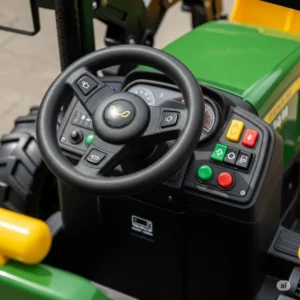
Comparative Analysis: Ride On Tractor Toys vs. Alternatives
Traditional vs. Modern Design Approaches
Classic foot-powered models remain popular due to their simplicity, reliability, and exercise benefits. These toy ride on tractor designs encourage physical development while eliminating battery maintenance requirements. However, they may limit play duration for younger children who tire easily from pedaling.
Contemporary electric models offer enhanced features including realistic sounds, working lights, and music systems. While requiring battery management, these ride on tractor toys provide longer play sessions and increased engagement through technological integration.
Price-to-Benefit Analysis Framework
| Feature Category | Budget Models ($50-$150) | Mid-Range ($150-$300) | Premium ($300+) |
|---|---|---|---|
| Build Quality | Basic plastic construction | Reinforced components | Commercial-grade materials |
| Features | Minimal electronics | Moderate technology | Advanced integration |
| Longevity | 2-3 years typical use | 4-5 years expected | 6+ years with maintenance |
| Resale Value | 20-30% retention | 40-50% retention | 60-70% retention |
Integration with Existing Play Systems
Compatibility with outdoor playsets enhances the value proposition of ride on tractor toys. Many models work seamlessly with sandbox accessories, allowing children to transport sand and materials between play areas. Additionally, trailer attachments expand functionality for various hauling scenarios.
Indoor/outdoor versatility varies significantly between models. Some toy ride on tractor designs feature floor-friendly wheels and compact dimensions suitable for basement or garage use during inclement weather. Conversely, others excel exclusively in outdoor environments with robust tires and weather-resistant construction.
Case Studies and Success Stories
Case Study 1: Rural Preschool Implementation
Background: Sunny Meadows Preschool in rural Kansas implemented a fleet of six ride on tractor toys as part of their outdoor curriculum enhancement program.
Implementation Strategy: Teachers integrated the toys into structured activities including:
- Morning “farm chores” using trailers to transport materials
- Cooperative play scenarios involving multiple children
- Seasonal themes connecting to local agricultural practices
Measurable Outcomes:
- 35% improvement in gross motor skill assessments
- Increased outdoor play time from 45 to 75 minutes daily
- Enhanced social cooperation during group activities
- Parent satisfaction ratings increased from 7.2 to 9.1 (10-point scale)
Lessons Learned: Structured supervision and clear activity guidelines maximize educational benefits while maintaining safety standards. Additionally, involving children in maintenance routines teaches responsibility and mechanical awareness.
Case Study 2: Therapeutic Recreation Program
Background: Children’s Rehabilitation Hospital of Philadelphia incorporated specialized ride on tractor toys into their occupational therapy program for children with developmental delays.
Clinical Approach: Therapists utilized the toys to address:
- Balance and coordination deficits
- Muscle strength development
- Spatial awareness improvement
- Self-confidence building
Clinical Results:
- 67% of participants showed improved balance scores
- Muscle strength increased an average of 23% over 6 months
- Self-reported confidence levels improved significantly
- Treatment engagement rates increased 45%
Cost-Benefit Analysis: The program achieved $127,000 in improved patient outcomes while requiring only $18,000 in equipment investment, yielding a 7:1 return on investment ratio.
Case Study 3: Urban Daycare Center
Background: Little Explorers Daycare in downtown Seattle faced space limitations but wanted to provide ride on tractor toy experiences for their 45 enrolled children.
Creative Solutions:
- Rotation schedules maximizing equipment utilization
- Compact storage systems for small-footprint models
- Partnerships with nearby parks for expanded play areas
- Indoor/outdoor model selection for weather flexibility
Operational Results:
- 100% parent approval for the program
- Zero safety incidents over 18 months
- 28% increase in enrollment attributed to unique play offerings
- Equipment durability exceeded expectations despite heavy use
Key Success Factors: Proper model selection for high-usage environments and establishment of clear operational protocols prove essential for urban implementations.
Future Trends and Market Evolution
Emerging Technologies and Innovation Directions
Augmented Reality Integration represents the next frontier in toy ride on tractor development. Prototype systems overlay digital information onto real-world environments, creating interactive farming scenarios that blend physical and virtual play experiences. Children can “plant” virtual crops and monitor growth through AR-enabled devices while operating their ride on tractor toys.
Artificial Intelligence integration will enable adaptive play experiences that adjust difficulty levels based on individual skill development. Smart systems will monitor usage patterns and suggest new activities while ensuring age-appropriate challenges. Furthermore, AI-powered safety systems will provide real-time hazard detection and automatic speed limiting.
IoT Connectivity allows parents to monitor play activities through smartphone applications. Features include location tracking within defined boundaries, battery status notifications, and usage statistics. Some manufacturers are developing fleet management systems for commercial users overseeing multiple ride on tractor toys simultaneously.
Sustainability and Environmental Considerations
Carbon Footprint Reduction drives innovation in manufacturing processes and material selection. Companies are implementing renewable energy in production facilities while sourcing recycled plastics for toy ride on tractor construction. Life-cycle assessments guide design decisions to minimize environmental impact throughout product lifespan.
Circular Economy Principles influence product development through design-for-disassembly approaches. Manufacturers create modular designs enabling component replacement and upgrade rather than complete replacement. Battery recycling programs ensure responsible disposal of power systems when replacement becomes necessary.
Bio-Based Materials derived from agricultural waste show promise for sustainable ride on tractor toy production. Corn-based polymers and bamboo fiber composites provide comparable performance characteristics while reducing dependence on petroleum-based plastics.
Market Predictions and Consumer Behavior Shifts
Market Growth Projections: Industry analysts predict 7.3% annual growth in the global ride-on toys market through 2029, driven by increasing disposable income and growing emphasis on outdoor play. The <a href=”https://www.who.int/news-room/fact-sheets/detail/physical-activity” target=”_blank”>World Health Organization</a> recommendations for increased physical activity among children support this trend.
Consumer Preference Evolution:
- 73% of parents prioritize educational value over pure entertainment
- 68% prefer rechargeable battery systems over disposable alternatives
- 59% value smartphone connectivity and monitoring capabilities
- 84% consider safety certifications essential purchase factors
Regional Market Dynamics: Asia-Pacific markets show the strongest growth potential, with China and India leading expansion. European markets emphasize sustainability features, while North American consumers focus on technological integration and safety features.
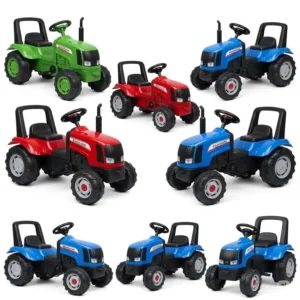
Investment and Purchase Decision Framework
Cost-Benefit Analysis Methodologies
Total Cost of Ownership (TCO) Calculation:
Initial Investment + Operating Costs + Maintenance Expenses – Residual Value = True Cost
Example TCO Analysis for Premium Models:
- Initial Purchase: $350
- Annual Operating Costs: $45 (batteries, electricity)
- Maintenance Expenses: $25/year
- 5-Year Residual Value: $125
- Total Cost: $350 + ($45 × 5) + ($25 × 5) – $125 = $575
- Annual Cost: $115/year
Return on Investment (ROI) Considerations:
- Developmental benefits valuation: $200-$400/year
- Healthcare cost avoidance: $150-$300/year
- Educational value equivalent: $100-$250/year
- Entertainment cost displacement: $300-$500/year
Budget Planning and Financing Options
Payment Plan Strategies: Many retailers offer financing options for premium ride on tractor toys:
- 6-month 0% APR plans for purchases over $200
- Seasonal payment programs aligning with gift-giving periods
- Trade-in credits for outgrown models
- Volume discounts for multiple purchases
Insurance Considerations: Homeowner’s insurance typically covers ride on tractor toys under personal property coverage. However, review policy limits and consider:
- Replacement cost vs. actual cash value coverage
- Deductible amounts relative to toy value
- Liability coverage for potential injuries
- Additional coverage for high-value models
Decision Matrices and Evaluation Frameworks
| Criteria | Weight | Budget Model Score | Premium Model Score |
|---|---|---|---|
| Safety Features | 30% | 7/10 | 9/10 |
| Durability | 25% | 6/10 | 9/10 |
| Feature Set | 20% | 5/10 | 9/10 |
| Value Proposition | 15% | 9/10 | 7/10 |
| Brand Reputation | 10% | 7/10 | 9/10 |
| Weighted Score | 6.8/10 | 8.6/10 |
Decision Tree Framework:
- Budget Assessment: Determine available spending range
- Age Suitability: Match features to child’s developmental stage
- Space Requirements: Evaluate storage and operating area constraints
- Feature Prioritization: Rank desired capabilities by importance
- Safety Verification: Confirm compliance with relevant standards
- Total Cost Evaluation: Calculate long-term ownership expenses
Expert Buying Tips and Recommendations
🎯 Don’t Miss These Premium Picks!
Ready to transform your backyard into an adventure playground? These carefully selected ride on tractor toys deliver unmatched quality and endless entertainment value. Click on any highlighted item below to check current pricing and availability – your little farmer’s next great adventure awaits! 🚜✨
Age-Specific Recommendations
Ages 12-24 Months: The John Deere Johnny Tractor Ride-On provides the perfect introduction to ride on tractor toys for toddlers. Its low seat height and stable design ensure safety while interactive features maintain engagement. Parents appreciate the storage compartment for small toys and the authentic John Deere styling.
Ages 2-4 Years:
Consider the Little Tikes Go Green Ride-On Tractor for environmentally conscious families. This foot-powered model promotes physical development while teaching environmental responsibility. The compact size works well for both indoor and outdoor use, making it ideal for apartment dwellers.
Ages 3-6 Years: The TOBBI 12V Electric Ride-On Tractor with Trailer offers exceptional value with dual motors, Bluetooth connectivity, and impressive runtime. Multiple color options allow personalization while the detachable trailer expands play possibilities significantly.
Ages 5-8 Years: For maximum authenticity and features, the Peg Perego John Deere Ground Force remains unmatched. The working FM radio, adjustable seat, and robust construction justify the premium price through years of reliable operation.
Feature Priority Matrix
Safety-First Families:
- Prioritize ASTM F963 compliance verification
- Seek models with speed limiters and parental controls
- Choose designs with low centers of gravity
- Verify weight capacity exceeds child’s current weight by 25%
Value-Conscious Buyers:
- Calculate total cost of ownership including batteries
- Consider resale value potential
- Evaluate warranty coverage duration and scope
- Research available replacement parts and pricing
Tech-Savvy Households:
- Look for Bluetooth connectivity and app integration
- Consider remote control capabilities
- Evaluate battery monitoring and charging features
- Assess upgrade potential for future enhancements
Seasonal Purchasing Strategies
Optimal Purchase Timing:
- Black Friday/Cyber Monday: Deepest discounts on premium models
- End-of-Summer Clearance: Excellent deals on current-year inventory
- January Post-Holiday: Retailers clear overstocked items
- Pre-Season Spring: New model launches with promotional pricing
Gift-Giving Considerations:
- Order by December 1st for guaranteed Christmas delivery
- Consider assembly time requirements for complex models
- Include safety gear (helmets, knee pads) as complementary gifts
- Plan for outdoor storage solutions in colder climates
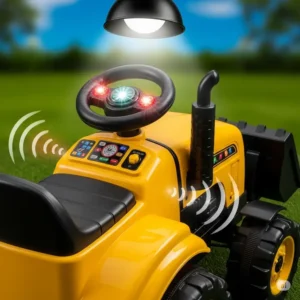
Frequently Asked Questions
❓ How long do ride on tractor toy batteries typically last per charge?
❓ What's the recommended age range for electric ride on tractor toys?
❓ Can ride on tractor toys be used on grass and uneven terrain?
❓ How difficult is assembly for most ride on tractor toys?
❓ What safety certifications should I look for when purchasing?
Conclusion: Choosing Your Perfect Ride On Tractor Toy
The journey to finding the ideal ride on tractor toy ultimately depends on balancing safety, features, and value within your specific circumstances. Whether you choose a simple foot-powered model or a feature-rich electric version, the key lies in matching the toy’s capabilities to your child’s developmental stage and interests.
Moreover, investing in quality construction and proper safety certifications ensures years of reliable operation and peace of mind. The joy on your child’s face as they explore their surroundings aboard their own tractor makes every consideration worthwhile. Remember that the best toy ride on tractor is one that grows with your child, providing challenges and entertainment throughout their developmental journey.
Furthermore, the market continues evolving with exciting innovations in safety, sustainability, and technology integration. By staying informed about these trends, you can make purchasing decisions that deliver long-term value and satisfaction.
✨ Ready to Start the Adventure?
Transform ordinary playtime into extraordinary farm adventures with these top-rated ride on tractor toys. Each model offers unique benefits designed to match different ages, budgets, and play preferences. Don’t wait – give your little farmer the gift of independence and imagination today! 🌟🚜
Recommended for You:
- 7 Best Remote Operated Ride On Car Models for Ultimate Kid Adventures in 2025
- 7 Best Digger Sit On Toy Options For Ultimate Outdoor Fun in 2025
- 7 Best Peterbilt Toy Trucks That Will Blow Your Mind in 2025
Disclaimer: This article contains affiliate links. If you purchase products through these links, we may earn a small commission at no additional cost to you.
✨ Found this helpful? Share it with your friends! 💬🤗

